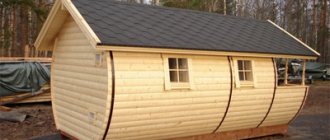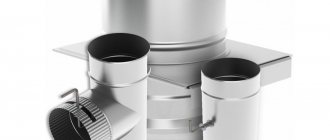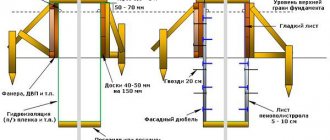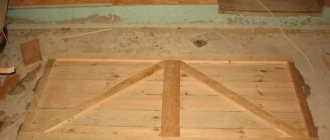It is believed that cinder block is excellent for the construction of residential buildings and other buildings, due to its availability and compliance with the required characteristics.
To further reduce the cost of the material, many begin to produce it themselves.
This can be done either using improvised means or using a special machine. The device is not cheap, but you can also build it yourself.
Description of the device
A vibrating cinder block machine is equipment that helps compact the mortar poured into molds . This is done so that there are no voids or air bubbles in the mass for making the block. The finished cinder block must fully comply with GOST, otherwise it cannot be used for building a house.
Important! Blocks that were made using a brick press always have better frost resistance, resistance to deformation, and strength than those that were made using other technologies.
The vibrating machine consists of several parts. In its lower part there is a frame where the vibrating table is located. It rests on rubber cushions. The vibrating table has several vibrators with adjustable strength.
The design has a backfill device for pouring concrete mixture . This is a tin container that allows you to pour concrete into the mold evenly and quickly. There is also a punch and a die.
The design includes a device for pressing the matrix with the pallet to the vibrating table. Vibrators for cinder blocks are equipped with electric motors and a drive.
Some vibrating machines use void formers. They are inserted into forms with concrete mixture and make holes in them. The output is a hollow cinder block.
What are they?
Machines for the production of cinder blocks are:
- automated stations;
- semi-automatic machines;
- manual equipment.
A fully automated machine is more suitable for enterprises that constantly sell cinder blocks. The productivity of such equipment is up to 1000 blocks per hour.
All you need to do is simply pour the cinder block ingredients into the container and press the start button. The mini-station will independently mix, pour, and compact stones ; the operator only needs to monitor the work. The advantage of such a vibrating machine is the lack of human intervention, the disadvantage is the high cost. Similar devices are produced by Bess.
Semi-automatic machines already require human intervention. Some operations here are automatic, but others will have to be performed manually. For example, in different configurations, the machine itself mixes the mixture for the stone, and the operator needs to lower the vibropress.
In other machines, the operator only participates in pouring the finished solution, and the rest is done by the vibrating table. The production of such machines is carried out by the Sibir company.
Manual equipment is considered the least productive, but it fully satisfies the needs for cinder blocks in private construction. The average cost of such a device will cost 200,000 rubles. A good representative is a device from VibropressStroy .
Reference! Depending on the type of block formation, machines can be mobile or stationary. The first ones are small in size and stones can be produced immediately on the construction site. Stationary equipment requires a lot of space, but its productivity is higher.
Principle of operation
All of the listed machines operate on a similar principle:
- The prepared solution is poured into a special container.
- The mixture is transported into the matrix.
- With the help of vibration, the mixture is leveled and compacted.
- If there are devices for voids, they are inserted into blocks with mortar and are strongly compacted under pressure and vibration.
- The matrix rises above the blocks and the finished mixture, already formed into blocks of the required size, is sent for drying.
The only difference between the devices is that in a fully automated machine all operations are performed independently. Even the mixing and transportation of the solution occurs automatically .
If the machine is manual, then the person must first prepare the slag mass in a concrete mixer, then pour it into molds, and then compact it well using a vibrating table. Again, you will have to carry the blocks to dry yourself.
Large production volume
A professional vibrating machine for the production of cinder blocks is necessary for the constant production of large batches of products. These are stationary models with full process automation. The feedstock is supplied to special bunkers along the carpet line. After its preparation, a matrix with forms is filled using a dosing system.
The technological scheme for such production is developed individually. All parameters are taken into account - the optimal volume of output, workshop area, composition of raw materials, etc. The result is a high-quality cinder block that can be used for multi-story construction.
How to choose the optimal equipment for cinder block production? It is necessary to focus on the volume and speed of production of products. In this way, continuous production of products can be organized.
How to make a vibrating machine at home?
If the machine is needed for individual production of blocks when building your own house, then there is no point in purchasing expensive equipment. You can try making it yourself .
Before you begin preparing tools and materials, you need to find the drawings. Such schemes can be found on the Internet on construction forums. There people share their experiences and talk in detail about the collection of equipment and its operation.
Necessary materials
To create a machine for the production of cinder blocks with your own hands, you need the following materials :
- galvanized metal sheet 3 mm thick;
- 1 meter of steel pipe with a diameter of 7-9 cm;
- steel strip 3 mm thick, 30 cm long;
- electric motor with power up to 1 kW.
A sheet of galvanized metal is necessary to create a matrix into which concrete and slag mixtures will be poured. The thickness of 3 mm is just right for these purposes.
The steel tube must be prepared for void formers . It is unlikely that self-production will produce only solid blocks. You can choose the diameter of the pipe yourself, depending on what diameter of the void you want to get at the outlet.
Note! Solid blocks are used to construct load-bearing walls, and cinder blocks with voids are used for internal walls and partitions.
The electric motor will be useful for arranging the drive, due to which the solution will be compacted in the molds.
Necessary tools and consumables
Consumables for assembling a vibrating machine will require a large amount of fasteners: screws, nuts, bolts, anchors. You also need to prepare tools :
- angle grinder or grinder;
- welding machine;
- vice;
- a set of keys.
It is also better to prepare screwdrivers and a screwdriver (if available) in advance - with the help of these tools you can assemble the machine much faster. For an angle grinder you need to choose a disc that can work on metal. You can’t do without a welding machine - the vibrating machine must be made with high quality and last throughout the entire construction phase.
If you have no experience with welding, then you shouldn’t risk it - this procedure requires special skills. In this case, it is better to hire an experienced welder and explain the task to him. You will need hex keys and others, so it is better to have a good set.
Step by step procedure
After all the materials, tools and consumables are ready, you can begin manufacturing the machine:
- At the first stage, you need to decide on the size of future blocks. This indicator must be written down in the drawing. The most common option is 200x200x400 mm.
- When making a matrix for blocks, you need to take into account the following point: the height of the matrix will be 50 mm higher than the height of the finished block. For manufacturing, a sheet of steel is cut using a grinder. You need to cut this sheet in advance, and also take care of the presence of partitions between the forms.
- Using a welding machine, the cut strips are welded together on the outside.
- Production of void former. The metal pipe is cut into lengths less than the height of the matrix by 5 mm. The device must have a cone-shaped shape; this can be achieved by clamping the pipe in a vice and welding it. The tubes must be blind on all sides; at the end they are connected to each other by welding.
- The void former is welded to the matrix or a removable structure is made.
- Bolts are attached to the outer long wall of the mold, onto which the electric motor is installed.
Do not forget that there must be a metal apron on the top of the matrix. At the final stage, the finished machine is placed in a frame, cleaned and painted.
Types of machines
block making device
Machines for cinder blocks can vary in design complexity:
- Collapsible structure made of wood or metal. It is very easy to make it yourself, and choose the sizes that will be convenient to work with later. It can have different sizes, depending on how many blocks will be produced at the same time. The easiest way would be to make forms from wood, in the longitudinal walls of which it is necessary to cut grooves for inserting partitions. Champagne bottles or water-filled plastic bottles are used to produce voids. Vibrocompression is not used in this option.
- A vibrating machine that produces higher quality, more durable products with more correct geometry. It consists of a form mounted on a table or a special stand. The vibrating machine also includes an electric motor. Using such a device, you can produce solid or hollow blocks in a fairly large quantity in a short time. The vibrating machine can be equipped with a lifting device that allows the blocks to be removed from the mold.
The type of machine should be selected based on the intended purposes. Let’s say that for the production of blocks for the construction of a garage or bathhouse, the simplest option is sufficient, but for mass production, the use of an electric brick making press becomes mandatory. The latter option is more preferable, since the material is additionally exposed to vibration, which increases the strength of the cinder block due to additional compaction.
Possible difficulties in the process
During the assembly process of the cinder block machine, errors and difficulties may arise :
- the vibrator is attached too loosely to the machine;
- there are no lids on metal forms;
- the finished product has not been painted;
- the tubes for the void formers are not welded on one side - then the solution will get there.
If you follow the instructions and select high-quality materials for the manufacture of the machine, then there will be no problems. During assembly, you can also use the services of professionals who can help with certain procedures.
Vibrator for machine
Any electric motor with an eccentric mounted on its axis can be used as a vibrator for a machine. This could be a metal plate with a displaced center of gravity or some kind of load. To shift the axis, it is enough to drill a couple of holes in the plate. Without an eccentric, creating vibration will be impossible. The vibrator must be rigidly attached to the machine. You can make a vibrator with your own hands from the engine of a washing machine or vacuum cleaner.
If you couldn’t find suitable used motors, you can buy an electric tabletop sander with two sanding discs in the store. Instead of sharpening discs, you need to install eccentrics offset to one side. Since this device already has convenient fasteners for installation on the machine, its use is more preferable.
Pros and cons of making your own
There are several advantages to making your own cinder block machine:
- reducing the cost of the construction process from homemade blocks;
- the ability to make a machine to suit your needs;
- the ability to equip the equipment with the necessary containers at your request;
- the ability to make a new matrix if it becomes unusable.
There are also disadvantages, including the length of time it takes to manufacture the machine and possible mistakes made due to inexperience.
Features of the material
Cinder block is a building material that has proven itself to be one of the most durable and unpretentious. It has considerable dimensions, especially if you place an ordinary brick next to it. You can make slag blocks not only in a factory setting. Some craftsmen undertake this work at home. If you strictly adhere to the technology, you get high-quality and strong blocks from which you can build a house or any outbuilding.
If a decision has been made to independently produce such products, then a number of its features should be taken into account.
- Cinder block is a fireproof material. It does not ignite itself, and does not intensify an existing flame.
- Really good quality blocks make long-lasting and sustainable homes/outbuildings. Such buildings will not be harmed by harsh climatic conditions, hurricanes, or constant gusty winds.
- Repairing cinder block buildings does not require extra effort and free time - all work can be completed in a short time.
- Cinder blocks are also distinguished by their large sizes, thanks to which buildings made from them can be erected very quickly, which pleases many builders.
- This material is durable. Buildings built from it can stand for more than 100 years without losing their previous characteristics.
- Another feature of cinder block is its soundproofing component. Thus, in dwellings made from this material there are no annoying street noises.
- The production of cinder blocks is carried out using various raw materials, so it is possible to select the optimal products for any conditions.
- What distinguishes cinder block is that it is not subject to attacks by various kinds of parasites or rodents. In addition, it does not rot, so it does not have to be coated with antiseptic solutions and other similar compounds designed to protect the base.
- Despite their decent dimensions, such blocks are light in weight. This feature is noted by many masters. Due to their lightness, these materials can be easily moved from one place to another without calling a crane. However, it must be taken into account that some types of such products are still quite heavy.
- Cinder block is not afraid of low temperatures.
- These blocks are distinguished by their high heat capacity, thanks to which they make cozy and warm homes.
- Temperature fluctuations do not harm the cinder block.
Cinder block buildings are usually decorated with decorative materials to give a more aesthetic appearance.
However, it is very important to remember that the cinder block cannot be covered with ordinary plaster (any “wet” work with this material should not be carried out). You can also use a special decorative block, which is often used instead of expensive cladding. When working with cinder block, it is important to take into account one important feature - this material is characterized by high water absorption, so it must be protected from contact with moisture and dampness
Otherwise, the blocks may collapse over time. Unfortunately, the geometry of the slag blocks leaves much to be desired. That is why, when laying floors from such material, you will have to constantly adjust individual elements - trim them and saw them. Cinder blocks have a relatively low cost.
Cinder concrete blocks - characteristics and purpose of the material
One of the reasons for the increased popularity of slag-filled concrete blocks is the low cost of the material. It is associated with the use of waste from metallurgical enterprises - slag - in the production process.
Along with traditional components, Portland cement and river sand, various aggregates are used:
- brick break;
- crushed stone screening;
- granite chips;
- various slags and ash;
- expanded clay particles.
The use of cinder blocks in construction allows you to reduce the cost of constructing walls several times
The manufacturing process is carried out in various ways:
- industrial method at specialized enterprises with processing of products in drying chambers;
- at home from available raw materials, using a self-assembled machine for making blocks.
Using homemade equipment you can produce various types of slag concrete products:
- full-bodied, with an increased margin of safety. They are used quite rarely, as they retain heat less well;
- hollow, characterized by high thermal insulation properties. To ensure strength, the volume of cavities should not exceed 1/3 of the total volume of the product.
The dimensions of the products are determined by the dimensions of the mold. When making products yourself, the size of the molding box can be any. However, many people prefer the standard dimensions of 19x18.8x39 cm.
The increased volume of the slag concrete block can significantly reduce the duration of various types of construction work:
- construction of capital walls;
- construction of internal partitions.
It is perfect for the construction of utility buildings, sheds, and storage buildings.
If you need to make a cinder block yourself, the machine allows you to quickly solve the problem. The resulting material has many advantages:
- high thermal insulation characteristics. Due to reduced thermal conductivity, the material prevents heat loss;
- increased dimensions and low weight. This makes it easy to transport products and quickly build walls from them;
- resistance to the development of microorganisms. This is achieved due to the properties of the slag included in the structure of the block;
- low price. A cinder block machine with your own hands allows you to make products that are cheaper than purchased blocks.
The material also has weaknesses:
- low durability. The period of operation of buildings made of slag concrete is up to three decades;
- reduced safety margin. The characteristics of the material allow the construction of buildings no more than two floors high;
- the appearance of cracks under the influence of shear forces. During shrinkage, cracking occurs along the cinder block mass.
To ensure an attractive appearance of buildings, the cinder block surface needs external cladding. These disadvantages do not stop developers who want to build a utility building or a small building in a limited time at low costs.
You can use homemade cinder blocks a month after they are made.
Mixture composition
The production of slag blocks at home obliges the craftsman to adhere to a specific composition, as well as certain proportions of all components. Thus, the binding ingredient in this material is usually cement of a grade not lower than M400. As for the filling component, it can consist entirely of slag or be mixed. The last option is obtained by adding a small amount of crushed stone, sand (simple or expanded clay), crushed brick and fine expanded clay.
When making cinder blocks, the following proportions must be observed:
- 8-9 parts of the filling component;
- 1.5-2 parts of astringent ingredient.
For example, out of 9 parts, at least 6 are accounted for by this component, and the rest is made up of crushed stone and sand. In theory, when making it yourself, it is permissible to use concrete or brick scraps, screenings.
The standard proportions of cinder block are:
- 2 parts sand;
- 2 parts crushed stone;
- 7 parts slag;
- 2 parts of Portland cement marked M400.
As for water, it is customary to add it in an approximate ratio of 0.5 parts. The result is a semi-dry solution. To ensure its high quality, you need to take a small handful and throw it on a hard surface. If the thrown lump crumbled, but under compression conditions regained its previous shape, then the composition can be considered suitable for further use.
If you plan to obtain colored cinder blocks, then the recipe is supplemented with colored chalk or brick chips. To increase the strength characteristics of this material, special plasticizers are used. In some cases, they resort to adding gypsum, ash or sawdust.
Drying
Drying is another important step in the production of slag blocks. The production process itself usually takes about 2-4 days. Sufficient strength characteristics that allow you to proceed to the use of blocks are usually achieved after 28 days. This is exactly the amount of time needed to obtain high-quality building material suitable for carrying out certain works. Cinder blocks can also dry naturally. Typically, this process takes place using a simple method of producing materials (in conventional forms).
To dry cinder blocks, special chambers are often used to prevent cracking during the hardening process. To prevent the blocks from becoming cracked, they must be moistened from time to time. This process is especially relevant if the production process is carried out in hot weather.











